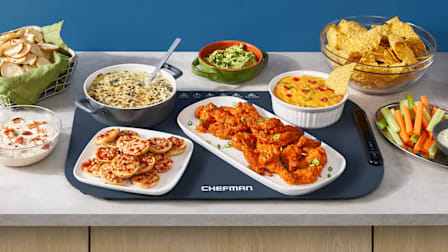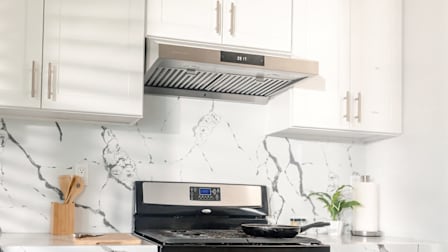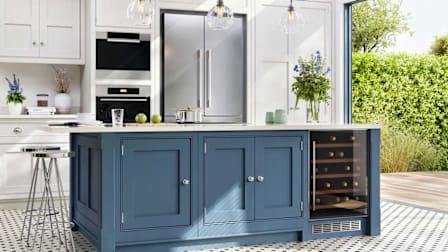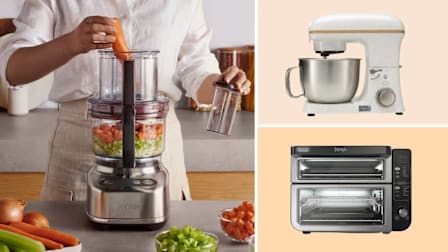Yes, Chef! A Breakdown of the Best Kitchen Gear on 'The Bear'
We tested the high-end kitchen equipment showcased on the Emmy-winning series in our labs and home kitchens. Much of it can help you raise your cooking game this holiday season.
When you shop through retailer links on our site, we may earn affiliate commissions. 100% of the fees we collect are used to support our nonprofit mission. Learn more.
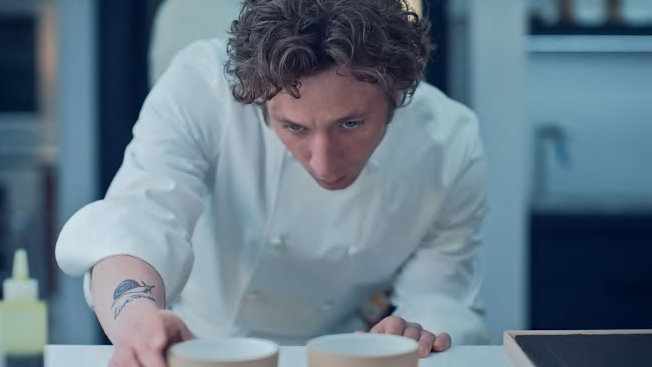
“The Bear,” FX’s critically acclaimed series, dropped its 10-episode Season 4 on Hulu on June 25. The show has not only given viewers a look into the high-pressure world of a Chicago fine-dining restaurant but also inspired many amateur chefs to try to cook better—especially during the holiday season—partly by upgrading their kitchen gear.
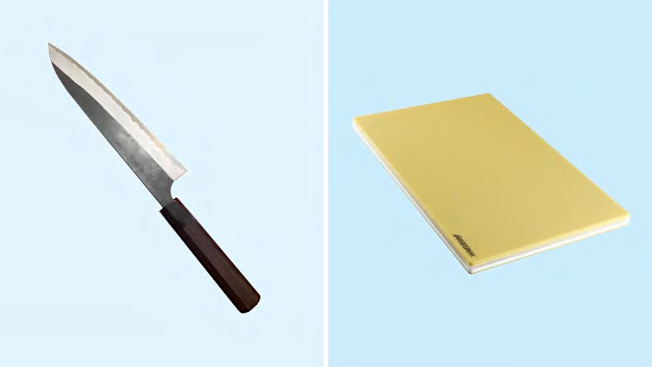
Photos: Consumer Repports, MTC Kitchen Photos: Consumer Repports, MTC Kitchen
Yoshimi Kato Carbon Steel Gyuto Knife
“The Bear’s” most profound gear-related story arc starts in the pilot, when the central character, Carmy, played by Jeremy Allen White (who’s also starring in the feature film “Springsteen: Deliver Me From Nowhere”), misplaces his knife.
He searches frantically for the hand-forged gyuto—a Japanese chef’s knife—assuming that someone is hiding it as a way to haze the new guy. (It has actually fallen on the floor.) Carmy has just taken the helm at his late brother’s Italian beef sandwich shop. The knife, a vestige of his markedly different prior gig as chef de cuisine at an Eleven Madison Park–like culinary oasis, is a serious piece of steel. It’s a 240 mm (roughly 9.5-inch) hand-forged work of art, designed by the bladesmith Yoshimi Kato in Japan’s legendary Takefu Knife Village.
The knife is highlighted throughout the Emmy-winning series, perhaps most notably in the three-Kleenex moment when Carmy gifts it to sous-chef Tina Marrero as she enrolls in culinary school to refine her skills.
The knife is so gorgeous and effective that I began hunting one down. In no small part because of the show’s popularity, it was sold out at most of the places I looked. But after trying it at a Manhattan cutlery shop, I bought one two years ago.
Then, it was just over $300. Now it’s up to $380. Expensive? Yes. Worth it, for a tool I use every single day and plan to pass on to my kids? Yes, again. It’s the kind of move that Lomonaco would endorse for a home chef. “I recommend a couple of pro-quality knives,” he says. “You don’t need a whole set of them, and they’ll literally last a lifetime if they’re taken care of.”
How does the knife perform? In a word: “Wow.” That’s what Hope said when I handed him mine and invited him to slice and chop a red onion. My knife, which differs from Carmy’s (a rosewood vs. cherry handle; 210 mm vs. 240 mm), feels like an extension of my hand. While it’s quite long, it’s surprisingly nimble. It can do anything from a delicate brunoise of vegetables to filleting a fish for sushi. The blade is so blazingly sharp that with a little practice, I found I could cut a carrot so thinly that it was actually translucent.
More to the point, a knife this good makes cutting a pleasure. I’ve found myself pausing “Top Chef” and sneaking downstairs to cut an onion with this knife just for the fun of it.
Shortcomings: This gyuto is a high-performance tool. Imagine a Porsche for your knife block. But like a Porsche, it needs to be treated with care. The super-hard carbon steel takes a razor-sharp edge, but it can be chipped if you twist or scrape the blade on a cutting board. It can also be damaged by cutting hard foods, like meat with bones or Parmesan cheese rinds. In “The Bear,” we see the chefs grabbing more rugged knives, like a stainless steel gyuto from MAC, for heavy-duty tasks.
Even when used properly, the Kato needs attention. That carbon steel blade must be wiped even after cutting a bunch of onions or it will develop dark stains and eventually rust. And it needs to be washed immediately after use and kept dry in either a wooden saya blade protector or some other secure knife holder. Don’t even let this knife look at your dishwasher.
While the Kato holds an edge very well and can be touched up nicely on a leather strop, you really need to sharpen it on a whetstone, like the Sharp Pebble model that our testers liked, instead of a mechanical knife sharpener.
Alternatives: The favorite in our recent evaluation of chef’s knives, the Henckels Premio 8” Chef’s Knife, isn’t nearly as sexy or as fun to cut with as the Kato gyuto. That said, the Henckels will probably be a more congenial partner for many home cooks. It can also serve as a solid utility knife for heavier work or to hand to a guest with more enthusiasm than knife skills who’s helping you prep. It slices cleanly, if not quite as precisely as that Japanese steel, and its handle is easy to grip with a nice balance. Plus, it doesn’t really require special handling. More to the point, it’s only $40.

Pro-quality knives will literally last a lifetime if they’re taken care of.
Hasegawa Cutting Board
You might wonder if there’s something symbolic about the pale yellow synthetic cutting boards that can be seen throughout the series.
I’ll leave the analysis to the TV critics, but the boards that Carmy and Crew use are special. While we don’t see a logo, they seem to be rubber boards made by a Japanese maker, Hasegawa. These boards, which now cost $98 for an 11x17-inch size, can be found in serious kitchens where precise cutting is everything. Which is why I bought one shortly after I purchased my heirloom knife.
How does the cutting board perform? It depends on what—and how—you’re cutting. The Hasegawa is a favorite of sushi chefs who aim to slice as thinly as possible. And if you slide a sharp knife gently through a protein, you’re rewarded with a silky landing that just makes you want to slice some more.
Shortcomings: If you like to rock chop, a technique where you’re sort of bouncing the knife along the board, you’ll hate the Hasegawa. Its rubberized surface doesn’t allow the knife to slide along the board. For this task (and really anything with vegetables), I use a custom wood board made by Jeff Bengston. (Chefs in many pro kitchens avoid wood boards because they can be hard to clean to the high food-safety standards required in many restaurants, though they’re great for home use.)
Alternatives: Our top-rated cutting board, the plastic Gorilla Grip, is very serviceable—and very inexpensive, at $8 each (a three-pack is $24). It’s thin and light, so it’s easy to pick up and move around. It’s also easy to clean, even in a dishwasher. No, it’s not as easy on your knives as the Hasegawa or a good wood board, but it’s perfectly fine with a knife like the Henckels.
Vitamix 5200 Blender
In Season 2, pastry chef Marcus travels to a high-end restaurant in Copenhagen. There, Luca, the chef he’s studying under, makes magic with a Vitamix blender. He purées blanched mint leaves, and the result is a gorgeous neon-green gelée. It’s enough to inspire serious blender envy.
How does the Vitamix perform? I bought CR’s tested sample, the Vitamix 5200, and it totally changed my mind about what a blender really is. I thought I was actually puréeing vegetables for a coulis sauce, but it was only after I tried them in the Vitamix that I realized the difference between a slightly grainy sauce and one that’s sensuously smooth. My biggest revelation: Following a tip that the cookbook author and recipe developer J. Kenji López-Alt got from a restaurateur friend, I began making hummus in my Vitamix. The end product was smoother than Al Green, and I raised my dip game from a 5.5 to a 9.5. Lomonaco reports that he’s got three Vitamixes in his restaurant kitchen. Hope is a fan as well and also bought a 5200 for his kitchen.
Shortcomings: The power of a Vitamix blender requires that you pay attention. I learned this the hard way. During a recent Boot Camp class at the Culinary Institute of America, I was making a red pepper coulis. I didn’t have the top on securely, and the red purée splattered, making my white chef’s coat look like something out of the special effects department from an “Evil Dead” film.
All-Clad D3 Cookware
As they start tearing down the old restaurant in Season 2 of “The Bear,” chefs Sydney and Tina bemoan the state of the battered restaurant-store pots and pans. Sydney starts to explain the difference between budget pans and good ones: “On the good-good, there’s like all these stacked layers of steel and in between them is an aluminum core . . . ” Toward the end of the season, the chefs at unbox a bunch of what looks to be All-Clad D3 cookware.
In Season 4, the All-Clad cookware is prominently displayed on racks and shelves in the restaurant kitchen. Chef Tina, trying to perfect a pasta dish, uses a round-bottom saucier pan, and several times, we can see the All-Clad logo at the base of the handle.
How does All-Clad D3 perform? I use All-Clad cookware in my kitchen—bought à la carte during the company’s periodic sales—and it performs great and still looks like new. Lomonaco agrees that it’s awesome. CR’s testers also find it worthy of a recommendation, with top marks in heating evenness and food release.
Shortcomings: The D3s don’t have a nonstick finish, which is fine, and actually preferable for most cooking because you can, say, sear a chicken breast and then deglaze the pan with wine and stock to make a quick-but-delicious pan sauce. But Lamonaco says that when he’s cooking eggs or even fish, he’ll use a relatively inexpensive nonstick pan. I do the same. I’m super-careful not to scrape the finish with metal utensils, and I inspect the cooking surface regularly. (When the finish gets less than pristine, I replace the nonstick with a new one.)
Le Creuset Dutch Oven
At the end of Season 3, in a dream sequence, Carmy is on a television cooking show making his family’s recipe for braciole (while confessing his family’s darkest secrets). His cookware of choice? A Le Creuset Traditional Round Dutch oven.
Hope agrees with this choice wholeheartedly. If he could have only a single piece of cookware in his kitchen, it would be a Dutch oven. “It braises, boils, makes great popcorn, and even sears in a pinch,” he says. “And as someone who has moved from a house that had a gas stove, then electric, then induction, it’s a pan that’s great on any range or cooktop.”
How does this Dutch oven perform? This 5.5-quart Le Creuset Signature’s speed of heating is top-notch in our tests. It’s easy to clean and impressive in overall performance. At 12 pounds, it weighs less than most, and our testers found that the loop handles are nice and wide, not always a given on Dutch ovens.
Shortcomings: The handles can get very hot, as Carmy found out in his dream sequence.
KitchenAid Commercial Series Mixer
Early in Season 4, pastry chef Marcus’s workstation morphs into a giant mess after a busy service, and Chef Sydney offers to help him clean up. We then get a brief glimpse of his now inspiringly tidy space.
A white KitchenAid stand mixer, not all that different from the one I have on my kitchen counter and the one you might have on yours, is displayed prominently on a shelf above his worktable.
How does the KitchenAid perform? I’ve had my smaller KitchenAid for more than 20 years, and it’s the first serious piece of kitchen equipment I purchased. It still works perfectly for mixing batter, whipping egg whites, and kneading bread, not to mention grinding meat with an attachment. I expect that mine might outlast Keith Richards.
Our testers found that the commercial-grade KitchenAid performed superbly at whipping and mixing, and was still strong at kneading. Its easy-to-use controls and attachments yielded solid marks for convenience.
Shortcomings: Marcus has the 8-quart KitchenAid Commercial series model, which is great for serious bakers. But it’s tall, which can make it difficult to fit on a counter under a kitchen cabinet, and expensive, at $950. Unless you’re a serious baker, you might be better off with a 4.5-quart KitchenAid like the $350 Artisan series, which performed just about as well in our labs.
8 Affordable Indulgences
While much of the gear in “The Bear” is high-quality and very expensive, there are some small kitchen items you can buy for $50 or less and gift to a fan of “The Bear”—or yourself.
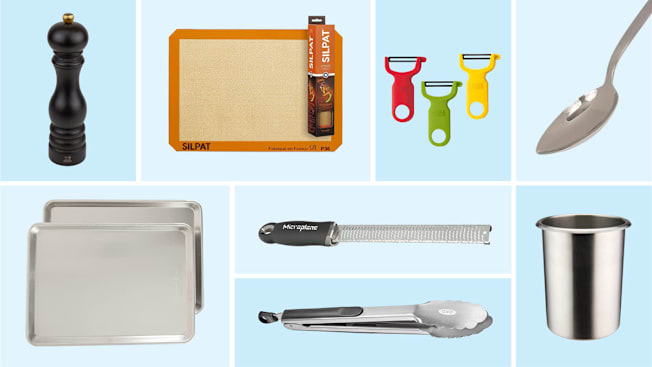
Photos: Manufacturers, Amazon Photos: Manufacturers, Amazon
Winco Bain-Marie
Often seen in classical French kitchens, a bain-marie is a tallish stainless container meant to hold a heated or cooled water bath. But in pro kitchens, like the one on “The Bear,” the bain-marie has become a receptacle that sits at a workstation to store utensils that are used the most.
In addition to spoons, scrapers, and spatulas you already own, try adding some of the small items from this list (the peeler, perhaps, or the sauce spoon, the tongs, and the Microplane).
Observant viewers will note that in Season 1, the chefs on “The Bear” use a stainless bain-marie that you can find at a restaurant supply store, like the Winco model above. In Seasons 2, 3, and 4, the Bearitos store their tools in a more stylish—and likely much more expensive—ceramic receptacle.
Where to buy: $14 at Amazon
Kuhn Rikon Peeler
If you want to pick a fight with a pro chef, talk about vegetable peelers.
On “The Bear”—and at my CIA Boot Camp—the preferred peeler is a Y-shaped device, like the Kuhn Rikon shown above. This allows you to pull straight down instead of turning your arm or wrist sideways with a straight potato peeler, like the one that a teenage Hope brought to his first restaurant job, where he almost got laughed out of the kitchen. There are also some Y-shaped models with curved carbon steel blades that can further elevate your carrot and potato peeling.
Where to buy: $5 at Amazon
Silpat Baking Sheet
If you’re a baker, even an aspiring one, parchment paper might seem like a small miracle. Lomonaco agrees but takes it one step further with reusable Silpat sheets or their generic equivalents, which cost as little as $3 each. These silicone mats, which you’ll see pastry chef Marcus using throughout “The Bear,” allow you to bake delicate creations without worrying about whether your concoction will stick to the sheet pan. In Season 4, the Silpats are again in heavy rotation as Chef Marcus perfects a dessert that’s a tribute to his late mother.
Where to buy: $20 at Amazon, $27 at Sur La Table
Peugeot Pepper Mill
High-end cooking is all about seasoning, and there’s nothing more basic to a good meal than freshly ground pepper. “I believe in quality pepper mills,” Lomonaco says. “That’s why I have a Peugeot, because the metal parts hold up.” I’ve got a Peugeot pepper mill, too, that I bought while shopping with my wife’s grandmother. It’s been through three homes and four kitchens, and still works perfectly.
Where to buy: $36 at Amazon
Nordic Ware Half Sheet Pan
“They’re heavy aluminum, they don’t warp, they don’t bend.” That’s Lomonaco’s endorsement of the classic sheet pan, a restaurant staple. He likes half sheet pans because they fit in a home kitchen oven. And they can even preempt cleanup: “I never put a pot in the oven without a pan underneath.”
Where to buy: $14 at Amazon, $18 at Wayfair
Oxo Good Grips Tongs
Hope likes the metal-tipped Oxo Good Grips 12-Inch Stainless-Steel Locking Tongs so much that he has six pairs in his kitchen and near his grill. The only downside is that you need to be careful if you’re using its bare-metal tips in a nonstick pan.
Where to buy: $16 at Amazon, $16 at Sur La Table
Gray Kunz Sauce Spoon
Throughout “The Bear,” you’ll see characters almost fetishizing this slightly oversized spoon. In one scene, we actually see Sydney tuck it in the back of her apron, almost the way a gunfighter might hide a Colt revolver.
And it’s a super-versatile tool. You can use it to baste meat or fish in a pan, which is what we see Carmy and Sydney do while preparing the Wagyu beef entrée in Season 4.
It’s also ideal for making quenelles—tiny decorative mounds of, well, anything, as we see Marcus struggle to learn the skill from master pastry chef Luca in Season 2. And, of course, you can use it to taste whatever it is you’re cooking—but no double dipping. The real deal 2.5-tablespoon spoon is expensive at $30, but you can get most of the way there with a small serving spoon.
Finally, at least one character uses the spoon to make a point in Season 4. When Tina asks Carmy if he’s seen his sister Natalie’s newborn, and he responds, “Which baby?”, she waves the Gray Kunz at him and says, “I’m gonna shove this spoon where the sun doesn’t shine.”
Where to buy: $30 at Amazon
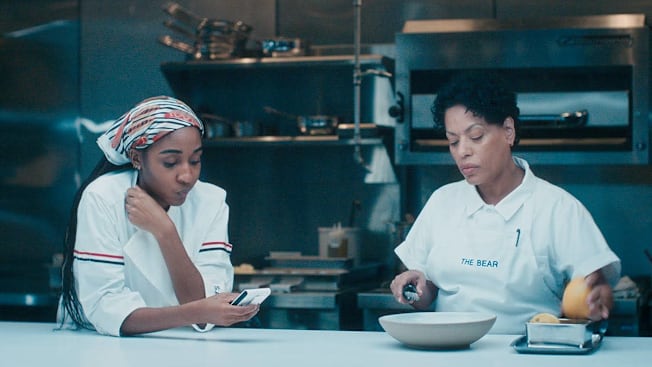
Photo: FX Photo: FX
Microplane Grater
This versatile tool can carry its weight in the kitchen and be used for far more than just grating Parmesan cheese. In Season 1, Chef Marcus ups his dessert game by using a microplane to elevate a chocolate cake with orange zest. In Season 4, Chef Tina uses a microplane to garnish her pasta dishes as she fights the clock.
“Even I’m surprised at how frequently I use my microplane grater,” Hope says. “I’ll often use it to grate garlic for salad dressing or a dipping sauce, zest citrus peel for a cocktail, or grate chocolate onto the top of a dessert.” Chef Carmy would approve.
Where to buy: $18 at Amazon
@consumerreports What are your kitchen confessions? 🤔 Paul Hope, our home and garden editor, shares his kitchen hacks, which appliance he can't live without, and which cooking gadget he thinks is totally overrated. Tap the link in our bio to see our guide to the top-rated refrigerators, dishwashers, ranges, and other appliances that are built to last. #kitchentok #kitchentiktok #kitchentools #cooktok
♬ original sound - Consumer Reports - Consumer Reports

















